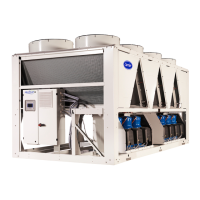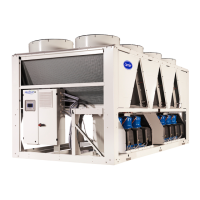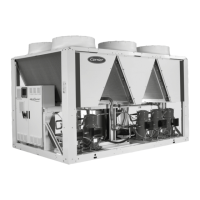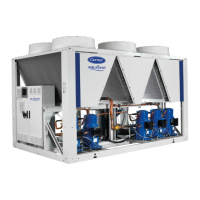21
Please refer to the certied dimensional drawings, supplied
with the unit.
The power supply must meet the specication on the unit's
nameplate.
The supply voltage must be within the range specied in the
electrical data table.
For connections, refer to the wiring diagrams and certied
dimensional drawings.
WARNING:
Operation of the unit with an incorrect supply voltage or
excessive phase imbalance constitutes misuse which will
invalidate the manufacturer's warranty. If the phase imbalance
exceeds 2% for voltage, or 10% for current, contact your local
electricity supplier at once and ensure that the unit is not
switched on until corrective measures have been taken.
After the unit has been started up, the power supply must only
be disconnected for quick maintenance operations (one day
maximum). For longer maintenance operations or when the unit
is placed in storage (for example, during winter when the unit
does not need to generate cooling) the power supply of the unit
must be maintained permanently
100 x max. deviation from average voltage
Average voltage
Example:
On a 400 V - 3 ph - 50 Hz supply, the individual phase voltages
were measured with the following values:
AB = 406 V; BC = 399 V; AC = 394 V
Average voltage = (406 + 399 + 394)/3
= 1199/3
= 399.7 say 400 V
Calculate the maximum deviation from the 400 V average:
(AB) = 406 - 400 = 6
(BC) = 400 - 399 = 1
(CA) = 400 - 394 = 6
The maximum deviation from the average is 6 V. The greatest
percentage deviation is: 100 x 6/400 = 1.5 %
This is less than the permissible 2% and therefore acceptable.
Wire sizing is the responsibility of the installer, and depends
on the characteristics and regulations applicable to each
installation site. The following is only to be used as a guideline,
and does not engage the manufacturer's liability.
After wire sizing has been completed, using the certied
dimensional drawing, the installer must verify the appropriate
means of connection and dene any modications necessary
on site.
The connections provided as standard for the customer's power
supply cables are designed for the number and type of sections
listed in the table below.
The calculations of favourable and unfavourable cases are
performed by using the maximum current possible of each unit
tted with a hydronic kit (see the tables of electrical data of
the unit and the hydronic module).
The study includes the standardised installation cases according
to IEC 60364: cables with PVC (70°C) or XLPE (90°C)
insulation with copper core; routing in accordance with table
52C of the standard.
The maximum length mentioned is calculated to limit the
voltage drop to 5 %.
IMPORTANT:
Before connecting the main power cables (L1 - L2 - L3),
always check 3 phases are in the correct order (clockwise)
before proceeding to the connection on the main disconnect
switch.
Motor
Max. connectable section
(1)
- Suspended overhead line (standardised
routing no. 17)
- Cable with XLPE insulation
- Conductors in ducts or multi-conductor cables in
closed conduits (standardised routing no. 41)
- Cable with PVC insulation, if possible
Section
(2)
(3)
Section
(2)
(3)
mm m - m -
2x70 2x95 21 1 x 50 180 XLPE Copper 2 x 50 350 PVC Copper
180 2x70 2x95 21 1 x 50 170 XLPE Copper 2 x 50 320 PVC Copper
200 2x70 2x95 21 1 x 70 205 XLPE Copper 2 x 70 380 PVC Copper
220 2x70 2x95 21 1 x 70 190 XLPE Copper 2 x 70 350 PVC Copper
2x70 2x95 21 2 x 50 220 XLPE Copper 2 x 70 300 XLPE Copper
300 2x70 2x95 21 2 x 50 200 XLPE Copper 2 x 70 270 XLPE Copper
330 2x70 2x95 21 2 x 70 240 XLPE Copper 2 x 95 310 XLPE Copper
2x95 2x185 24,5 2 x 70 220 XLPE Copper 2 x 95 280 XLPE Copper
400 2x95 2x185 24,5 2 x 70 200 XLPE Copper 2 x 120 310 XLPE Copper
430 2x95 2x185 24,5 2 x 95 240 XLPE Copper 2 x 150 340 XLPE Copper
470 2x240 2x240 37 2 x 95 220 XLPE Copper 2 x 150 320 XLPE Copper
520 2x240 2x240 37 2 x 120 240 XLPE Copper 2 x 185 330 XLPE Copper
(1) Connection capacities actually available for each unit. These are dened according to the connection terminal size, the electrical box access opening dimensions and the available space inside the
electrical box.
(2) Selection simulation result considering the hypotheses indicated.
(3) If the maximum calculated section is for an XLPE cable type, this means that a selection based on a PVC cable type can exceed the connection capacity actually available. Special attention must be
given to selection.
The protection against direct contact at the electrical connection point is compatible with the addition of fanout cables. The installer must determine whether these are necessary based on the cable
sizing calculation.

